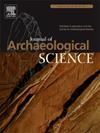早在公元前7千年,中国南部沿海的早期岛屿稻农
IF 2.6
1区 地球科学
Q1 ANTHROPOLOGY
引用次数: 0
摘要
农业和人口从东亚大陆向东南亚和大洋洲岛屿的传播是泛太平洋地区最后一次影响深远的史前现象。然而,关于早期稻农是否以及何时占领这些岛屿的考古植物学数据有限,因此存在争议。因此,我们对中国南部沿海海滩岛的两个新石器时代贝壳丘遗址进行了植物岩、OSL和放射性碳定年分析。新的日期与早期的绝对年代研究结果相结合,为这些地点提供了一个年表。结果表明,克丘头文化的两个占领高峰集中在大约6800 ~ 6300 cal BP和5800 ~ 5300 cal BP之间。在这两个地点的新石器时代地层中观察到连续的水稻植物岩记录,包括水稻球状。此外,具有≥9个鱼鳞装饰的水稻球状植物岩占41%,高于野生水稻的标准,表明在6800 cal BP或更早的时候,海滩岛已经出现了水稻种植。这些发现为海坛岛上水稻种植提供了最早的证据,为第一批农民的海上航行和对中国南部沿海岛屿的殖民提供了证据。本文章由计算机程序翻译,如有差异,请以英文原文为准。
Early Island rice farmers on the South China Coast during the 7th millennium BP
The spread of agriculture and population from Mainland East Asia to the islands of Southeast Asia and Oceania was the last far-reaching prehistoric phenomenon in the Pan-Pacific region. However, archaeobotanical data examining whether and when early rice farmers occupied these islands is limited and thus contested. Thus, we performed phytolith, OSL and radiocarbon dating analyses of two Neolithic shell mound sites on Haitan Island on the South China Coast. The new dates were amalgamated with the results of earlier absolute dating studies, providing a chronology for these sites. Our results indicate that the two occupation peaks of the Keqiutou Culture centred between approximately 6800–6300 cal BP and 5800–5300 cal BP. Continuous rice phytolith records—including rice bulliforms—were observed in the Neolithic layers at the two sites. Moreover, rice bulliform phytoliths with ≥9 fish-scale decorations accounted for 41%, higher than the established standard for wild rice, suggesting that rice cultivation had already emerged at 6800 cal BP on Haitan Island and probably earlier. These findings provide the earliest evidence of rice cultivation on Haitan Island, adding evidence of the first farmers’ sea voyages and colonisation of the South China Coast islands.
求助全文
通过发布文献求助,成功后即可免费获取论文全文。
去求助
来源期刊

Journal of Archaeological Science
地学-地球科学综合
CiteScore
6.10
自引率
7.10%
发文量
112
审稿时长
49 days
期刊介绍:
The Journal of Archaeological Science is aimed at archaeologists and scientists with particular interests in advancing the development and application of scientific techniques and methodologies to all areas of archaeology. This established monthly journal publishes focus articles, original research papers and major review articles, of wide archaeological significance. The journal provides an international forum for archaeologists and scientists from widely different scientific backgrounds who share a common interest in developing and applying scientific methods to inform major debates through improving the quality and reliability of scientific information derived from archaeological research.
 求助内容:
求助内容: 应助结果提醒方式:
应助结果提醒方式:


